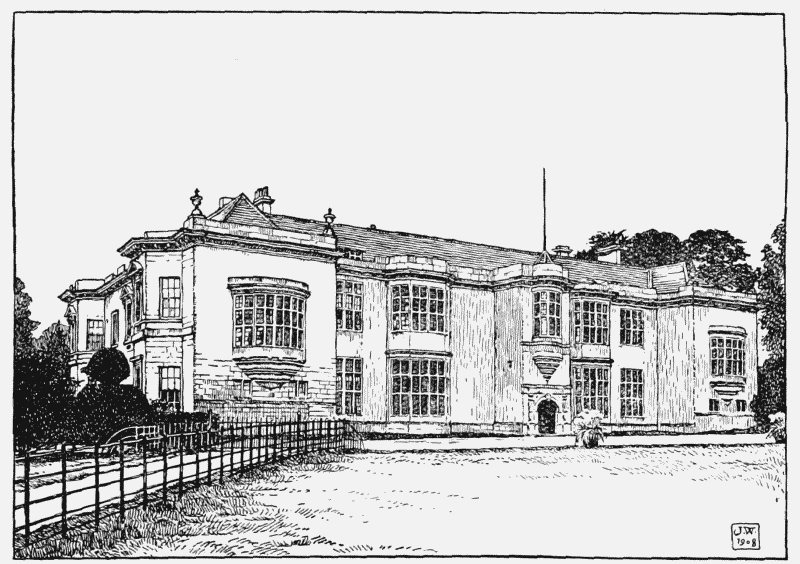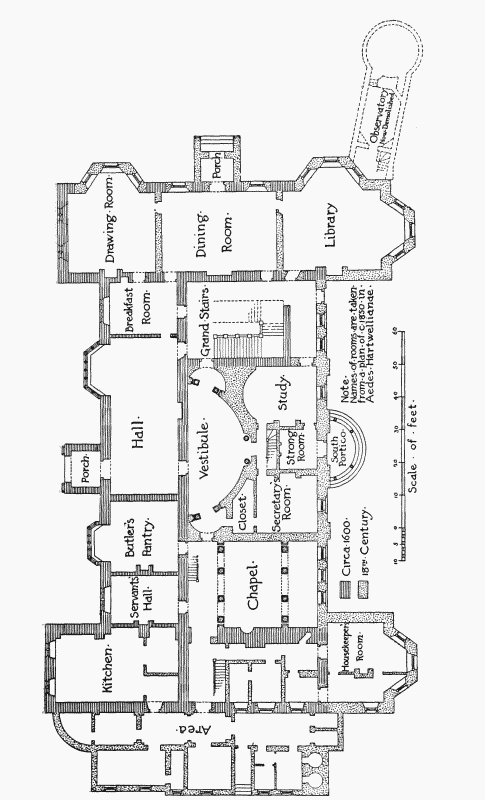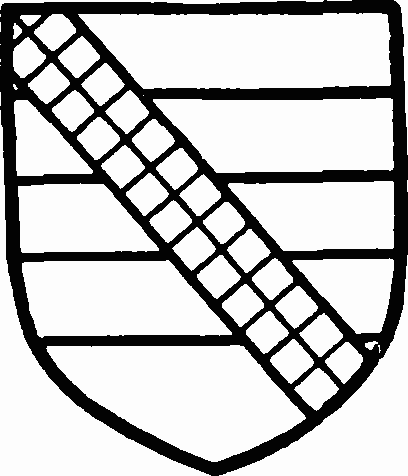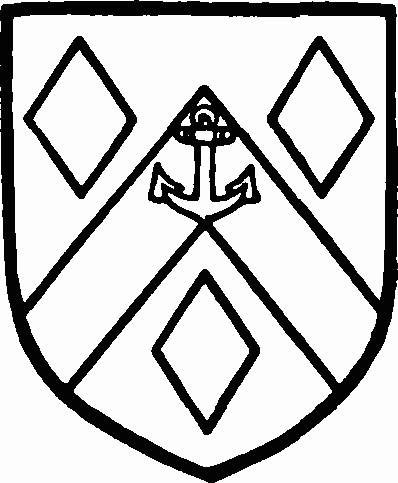A History of the County of Buckingham: Volume 2. Originally published by Victoria County History, London, 1908.
This free content was digitised by double rekeying. All rights reserved.
'Parishes: Hartwell', in A History of the County of Buckingham: Volume 2, ed. William Page (London, 1908), British History Online https://prod.british-history.ac.uk/vch/bucks/vol2/pp293-298 [accessed 23 April 2025].
'Parishes: Hartwell', in A History of the County of Buckingham: Volume 2. Edited by William Page (London, 1908), British History Online, accessed April 23, 2025, https://prod.british-history.ac.uk/vch/bucks/vol2/pp293-298.
"Parishes: Hartwell". A History of the County of Buckingham: Volume 2. Ed. William Page (London, 1908), British History Online. Web. 23 April 2025. https://prod.british-history.ac.uk/vch/bucks/vol2/pp293-298.
In this section
HARTWELL
Herdwelle (xi cent.); Hertwell (xiii cent.).
The parish of Hartwell lies in the Vale of Aylesbury, bordering on Aylesbury parish on the west. The height of the land varies from 200 ft. to 300 ft. above the Ordnance datum. Various streams run through the parish and join the River Thame, and there are several springs of water. The subsoil is London Clay, Kimmeridge Clay, and Portland Beds; (fn. 1) the surface soil is rich loam. The population is chiefly occupied in agriculture, on grazing farms or in market gardens. A large brick-kiln, however, provides work for a considerable number of men. The main road from Thame to Aylesbury passes through the parish, and the nearest station is also at Aylesbury. The common fields of Hartwell were inclosed under an Act of 16 George III, the award being given in 1779. The parish contains 918 acres; (fn. 2) 853 are laid down in permanent grass, and 234 are arable land. (fn. 3) Various Anglo-Saxon remains have been dug up, chiefly consisting of iron weapons. The park in which Hartwell House stands takes up a great part of the parish, and the church is within its boundaries and close to the house. The old rectory is a pretty piece of early 18thcentury brickwork with a well designed cornice. There is no village of Hartwell, but the chief collection of houses is known as Lower Hartwell, on the north-west boundary of the park, and is composed for the most part of small half-timbered and thatched cottages.
Hartwell House is an interesting example of a mid18th-century remodelling of an early 17th-century plan. The latter was evidently of the H form, with a main block standing east and west, about 105 ft. long, and east and west wings of about the same length, the main block joining the wings near their north ends; the wings extended southwards and formed two sides of a courtyard open to the south, with projecting buildings in the north-east and northwest angles, the former containing the principal staircase, while the site of the latter is now occupied by the chapel, an arrangement which may have existed in the older building. In the middle of the 18th century the east front was rebuilt and the court between the wings on the south almost completely filled in with new rooms. The north front, however, with the exception of the parapet and cornice, retains its old character. The house is faced with wrought stone in two stories, and is entered from the north through a two-story porch in the middle of the front. The doorway has a panelled semicircular arch flanked by pilasters carrying an enriched frieze and cornice, and above it is an extremely handsome projecting semicircular oriel window, with stone mullions and transoms springing from a large conical corbel richly carved with lines of architectural ornament. The porch is flanked on either hand, but not with exact symmetry, with tall mullioned and transomed bay windows, that on the east side lighting the hall, and the other a room now the butler's pantry. Both bays have similar windows on the first floor. The hall has a large fireplace in the south wall, and is a handsome room somewhat overdecorated with plaster panels and ceiling during the 18th-century operations; it preserves none of its original fittings, all traces of the screens at the west having disappeared. At the south-east are doorways to the main staircase and to the breakfast-room. The north ends of the two wings of the house project some 15 ft. from the north front of the main block, and have, at what was the old first-floor level, large projecting bay windows resting on moulded corbel courses. The present first floor is at a higher level and cuts across the lower lights of the windows.

Hartwell House: The Entrance Front
At the south-west of the hall a doorway, originally opening from the south end of the screens, now leads into a large semicircular lobby two stories in height, lit by a skylight and with a gallery running round at the first-floor level. The decoration of this is somewhat later in character than the other 18th-century work, being in the style of the brothers Adam. The great staircase south-east of the hall is part of the 17thcentury house, and an unusually fine example of its style. The stairway is 8 ft. wide, all of oak and decorated at intervals by large panelled newels surmounted by statues of gods and heroes, &c., amongst them Samson with the Jawbone of the Ass and Hercules in his Lion Skin. A curious feature is that the swords and spears carried by these figures are loose and may be removed, possibly in order that, upon state occasions, they might be replaced by flambeaux. The breakfast-room, east of the hall, is panelled with 17th-century oak panelling in small squares. The east wing was presumably gutted in the 18th century and completely rearranged. The great chamber was probably at its north end lighted by the large bay window which still shows on the north front; the wing now contains the dining-room, drawing-room and library, all of which are decorated in a manner somewhat similar to the hall. The library in particular is an excellent piece of work, with ranges of white-painted book shelves with gilded wire screens, containing an interesting collection of books. From the east side of the library an observatory was built out early in the 19th century, but has now been pulled down. A chimney-piece in this wing bears the date 1658, but its original position isuncertain.
On the first floor above the hall and beyond it tothe west is the long gallery now used as a museum, and west again of this is a small bedroom completely panelled in 17th-century oak and furnished with some very fine carved oak, part of which came from the hall, and part was brought here in recent years. It also contains some good tapestry of about the same date.
The west wing is mainly occupied by the servants' quarters, and the space corresponding to the staircase on the east is taken up by a room formerly used as a chapel.
The entrance to the park, quite close to the house on the west, is by means of a monumental arch, in a range of 18th-century stabling. The house contains a number of good paintings by Vandyke, Reynolds, Kneller, &c., and collections of Egyptian antiquities, fossils, and illuminated manuscripts. Historically it is interesting as the abode of the exiled French court from 1810 to 1814, when its accommodation seems to have been severely tested, as some 140 persons were crowded into it and the outbuildings. Louis XVIII used the library as his reception-room, and the study and an adjoining room as his private apartments. The Prince and Princess de Condé inhabited and slept in the drawing-room, and the Duke and Duchess d'Angoulême in the upper floor of the east wing. During the residence of the court the queen died, and the room over the library was fitted up for her lying in state. An interesting relic of this part of the history of the house is the confessional of the royal family in the room used by them as a chapel, and there are also pictures of the king and the Prince de Condé, the missal and lectern of the Archbishop of Toulouse, &c., and the names then given to the rooms are still to be seen painted over the bells, 'The King's Room,' 'The Queen's Room,' 'The Archbishop's Room,' and so forth.
Manor
Alwin, a thegn of King Edward, held the most important part of the township of HARTWELL. (fn. 4) After the Norman Conquest this manor was granted to William Peverel, and in the Domesday Survey it was assessed at 6 hides and 3 virgates of land. (fn. 5) It belonged to the honour of Peverel of Nottingham, which came into the hands of the Crown shortly after the accession of Henry II. (fn. 6) In 1086 William Peverel had sub-infeudated Tekel with this manor. (fn. 7) At the close of the 12th century Walter de Hertwell held one knight's fee of the honour of Peverel. (fn. 8) He died before 1205, in which year Barnabas son of Walter gave the king 40 marks to have seisin of the knight's fee (fn. 9) in Hartwell, which had belonged to his father Walter de Hertwell. (fn. 10) Barnabas probably died before 1229, when Walter de Hertwell paid a fine to be quit of military service across the seas, due from his lands. (fn. 11) He also paid scutage in 1234. (fn. 12) Soon after this he was succeeded by William de Hertwell, who, however, died before 1247. (fn. 13) In 1254 his heir was still a minor (fn. 14) in the wardship of Ralph son of Nicholas, and was presumably the William son of William de Hertwell who held the manor in 1271. (fn. 15) This William granted the manor to a sub-tenant in that year, (fn. 16) and his descendants probably became the mesne lords of the manor. The de Lutons, the new demesne lords, held it of successive Hertwells, (fn. 17) the last mention of them being in 1645. (fn. 18) In 1271 (fn. 19) William de Luton and Alice his mother, who may have been a daughter of William de Hertwell the elder, (fn. 20) were joint grantees of the manor; William is mentioned as holding it in 1273 (fn. 21) and Alice in 1280. (fn. 22) The two are mentioned as joint tenants in the same reign. (fn. 23) William de Luton appears in 1286 in a conveyance of land in Hertwell, (fn. 24) but Alice de Luton was seised of one knight's fee at her death in or before 1294. (fn. 25) Her son only lived till the next year, his heir Thomas being a minor. (fn. 26) Beatrix his widow held land in Hartwell as part of her dower, (fn. 27) and also had custody of Thomas's lands until he came of age in 1300. (fn. 28) A settlement was made in 1325, by which Thomas de Luton and Margery his wife were to hold the manor for their lives, with remainder to their son Nicholas and Joan his wife and the heirs of his body, and then with remainder to the right heirs of Nicholas. (fn. 29) Nicholas had already been granted 6 messuages and 3 virgates of land belonging to the manor. (fn. 30) Thomas and Margery both had died before 1346, (fn. 31) and Nicholas held the manor of Hartwell until 1359–60. (fn. 32) He was succeeded by his son Robert who died circa 1391 leaving a boy of twelve as his heir. (fn. 33) This boy was the last of the Lutons. He apparently died before coming of age, and the manor passed to the descendants of his sister Eleanor. (fn. 34) Her daughter Agnes was the heiress of the Lutons and married Sir Thomas Shingleton. Agnes also had an only daughter Elizabeth, who married Richard Hampden of Great Kimble. (fn. 35) After the death of Sir Thomas Shingleton his widow married again— Petite, and on her death in 1480 was succeeded by her grandson William Hampden. (fn. 36) Hartwell Manor was held by Thomas, (fn. 37) Jerome, (fn. 38) Michael, (fn. 39) and Alexander Hampden in turn. (fn. 40) On the death of Alexander in 1618–19 the manor passed to Thomas Lee, sen., of East Claydon, his kinsman. (fn. 41) The Lees of Hartwell held the manor without interruption (fn. 42) until the death of the Rev. Sir George Lee, bart., in 1827. (fn. 43) Under his will the manor passed to the descendants of William Lee, Lord Chief Justice of England, the second son of Sir Thomas Lee, bart., who died in 1690. The grandson of the Lord Chief Justice died without direct heirs, having taken the name of Antonie instead of Lee. (fn. 44) John Fiott the son of his second sister Harriet, under the wills of his uncle William Lee Antonie and of Sir George Lee, succeeded to the estates of the Lee family, taking the name of Lee.

Hartwell House: Ground Plan
John Lee left no children, and his estates passed to his brother, the Rev. Nicholas Fiott, who then took the name of Lee. He died in 1858 (fn. 45) and was succeeded by his son Lee Percyvale, who, however, died in the same year, the next heir being his brother, Colonel Edward Lee, the present lord of the manor.

Lee. Azure two bars or with a bend checky or and gules over all.

Fiott. Azure a cheveron between three lozenges or with an anchor sable on the cheveron.
The service by which the manor of Hartwell was held was complicated by the grant from the Hertwells to the Lutons.
The former held by military service of the honour of Peverel, performing, for Hartwell and Little Hampden, the service due from one knight's fee. (fn. 46)
This service was afterwards performed directly to the lord of the honour of Peverel by the Lutons, (fn. 47) who held the manor of the Hertwells by a nominal yearly rent of one clove gillyflower. (fn. 48) This rent was mentioned so late as 1645. (fn. 49)
The double service seems to have given rise to some confusion with regard to the overlordships, the Lutons and their successors being sometimes described as holding of the king in chief as of the honour of Peverel, and at other times as holding of the Hertwells. (fn. 50)
The manor of Hartwell did suit to the court of the honour of Peverel. (fn. 51) The bailiffs of the honour held the pleas of replevin, the view of frankpledge, and also had the return of writs within the manor.
These liberties existed in the time of Henry II, and practically resulted in the exclusion of the sheriff and his officers from the manor. (fn. 52)
In 1280, however, Alice de Luton obtained the privilege of freedom from suit to the honour court for her life for her men whether free or bondsmen. (fn. 53) She also was quit both of attendance from the view of frankpledge at the same court and of the payment of 8s. a year for her own view (fn. 54); she obtained leave to hold the assize of ale in her own court and to receive the fines for trespasses against it. (fn. 55)
In Domesday Book several pieces of land are mentioned as belonging to Hartwell, (fn. 56) which were apparently at some later date severed from the parish. The manor held by the Hertwell and Luton families apparently included the whole of the later parish of Hartwell. In 1254 the fee contained 6½ hides, so that it had varied but little from the assessment in 1086, at 6 hides 3 virgates. (fn. 57)
Besides this land belonging to the honour of Peverel, the Bishop of Bayeux held 4 hides in Hartwell, three of which Helto held of him, while the fourth was in the hands of Robert. (fn. 58)
In the time of King Edward the 3 hides were held by three sokmen. (fn. 59) One, a man of Archbishop Stigand, held half a hide; the second, a man of Earl Leofwine, had 2 hides; and the third, a man of Avelin, held half a hide. Avelin, a thegn of King Edward, himself held the hide given to Robert after the Conquest. (fn. 60) This land presumably passed with the rest of the Bishop of Bayeux's land to the Munchesney family and belonged to their barony of Swanscombe. In 1302–3 Hugh de Vere, who had married Dionysia, the heiress of the Munchesneys, held half a knight's fee in Hartwell. (fn. 61) Aymer de Valence inherited the honour of Swanscombe, and in 1346 his widow held this half fee. (fn. 62) This land may perhaps be identified with the manor of West Orchard in the township of Hartwell in the parish of Stone. (fn. 63) Walter de Vernon also held half a hide of land in Hartwell of the king in chief in 1086. He had succeeded Turgot, a thegn of King Edward. (fn. 64) Another 2 hides were held in chief by William the chamberlain, and Robert held them as his sub-tenant. Previously Wlmar, a priest of King Edward, had held this land. (fn. 65)
Church
The church of THE ASSUMPTION OF OUR LADY is a curious structure, begun in 1753 and finished in 1755, the chapter-house of York Minster having been taken as the source of its design, though the details are founded on 15th-century work. It consists of an octagonal nave with a small eastern sanctuary with a tower above it, balanced by a similar tower set against the west side of the octagon.
The east window is a very poor thing of five lights, and there are three-light windows with 15th-century tracery in the north-west, south-east, north-east, and south-west faces, with shafted jambs and crocketed and finialled labels, all executed in plaster. There are north and south doors, and the building is further lighted by quatrefoiled openings over both doors and windows. The principal entrance is from the west, the lowest stage of the tower forming a porch. Over the inner door, and opening into the body of the church, is a small gallery serving as a private pew to the Lee family, who built the church.
The ceiling is of plaster in the form of elaborate fan vaulting springing from the internal angles. There are no fittings in the church of any interest.
Beneath the church is a vault, and over the north and south doors are two boards bearing painted inscriptions commemorating those whose remains were placed there at the building of the church, having been removed from the old structure, and many whose bodies have been placed there since. The earliest names recorded are those of Sir Alexander Hampden, buried in 1617, and Dame Elizabeth Hampden his widow, buried in 1675. Amongst others also recorded are Sir Richard Ingoldsby of Waldridge, Buckinghamshire, buried 1685, and his wife Dame Elizabeth Ingoldsby, who was also the widow of Thomas Lee of Hartwell. Sir Thomas Lee, bart., son of Sir Thomas Lee of Dinton, 1690, and many more of the same family, notably Sir William Lee, kt., Lord Chief Justice of the King's Bench, died 1754, who contributed £1,000 towards the cost of the church.
The tower contains three bells, the treble by Richard Chandler, 1691, the second by Warner, 1906, and the tenor is inscribed R. S., Esq., 1715. (fn. 66)
The first book of the registers contains baptisms and burials from 1550 to 1741 and marriages from 1553 to 1743. This book also contains the burials in woollen from 1678 and also an interesting list of the inhabitants of the parish in 1730. The second book contains baptisms and burials from 1742 to 1812, and there is a MS. marriage book containing entries from 1754 to 1812.
Advowoson
The church of the Assumption of the Virgin Mary, (fn. 67) in the parish of Hartwell, is a rectory, the chapel of Little Hampden being appendant to it until 1892. The separation took place by Order in Council, dated 28 June 1892, and by a second Order, dated 18 August in the same year, the rectory of Hartwell and the vicarage of Stone were united. (fn. 68) The advowson has apparently always been held by the lords of the manor. The Lutons in the 14th century made a settlement of the manor and advowson, (fn. 69) and from them it passed successively o the Hampdens (fn. 70) and the Lees. (fn. 71) Some time before the Reformation an acre of land was given in Hartwell to provide a light; it was worth 8d. a year in the 16th century. (fn. 72)
Charities
Louis XVIII, King of France, who resided at Hartwell House for several years during the French Wars, forwarded to Sir George Lee, bart., £100 to be applied for the benefit of the poor of the parishes of Hartwell and Stone. The gift is represented by £117 consols, with the official trustees. The dividends amounting to £2 18s. 4d. are distributed at Christmas in sums of 2s. 6d. to 6s. to widows and labourers.
'Dr. Lee's Charity' consists of £112 13s. 4d. consols, with the official trustees, bequeathed, 1868, by will of Cecilia, wife of the late John Lee, LL.D., of Hartwell House. The dividends amounting to £2 16s. 4d. are, under a declaration of trust, 1889, applied by the rector and churchwardens for the benefit of the poor not in receipt of parochial relief, usually in the distribution of coals.